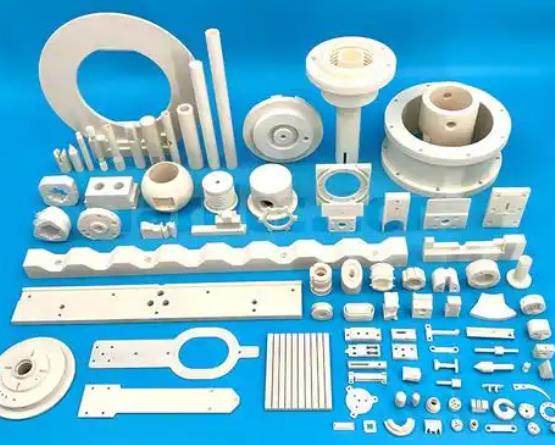Is aluminium oxide in ceramics toxic?
The aluminium oxide used in ceramic products is generally not harmful to the human body.
I. What is aluminum oxide?
Aluminum oxide is a chemical substance, a compound of aluminum and oxygen.Aluminium oxide is a chemical substance, a compound of aluminium and oxygen. It is often used in ceramic products because it can enhance the hardness and wear resistance of ceramics.

II. The safety of aluminium oxide
It is often used in ceramic products because it can enhance the hardness and wear resistance of ceramics.
II. The safety of aluminum oxide
Some people may be concerned about whether using ceramic products containing aluminium oxide will cause harm to health. In fact, in most cases, aluminium oxide is safe.
When manufacturing ceramic products, aluminium oxide is usually used together with other chemical substances, such as silicates and glazes. These chemical substances melt and combine at high temperatures to form ceramic products. This means that aluminium oxide is usually fixed in the structure of the products and does not release.
ome people may be concerned about whether using ceramic products containing aluminum oxide will cause harm to health. In fact, in most cases, aluminum oxide is safe.
When manufacturing ceramic products, aluminum oxide is usually used together with other chemical substances, such as silicates and glazes.In addition, aluminium oxide is also a common substance in the human body. These chemical substances melt and combine at high temperatures to form ceramic products. It can be found in food and water. This means that aluminum oxide is usually fixed in the structure of the products and does not release.
According to data from the US Environmental Protection Agency, the intake of aluminium oxide should be controlled at less than 50 milligrams per day.In addition, aluminum oxide is also a common substance in the human body. This amount is relatively low, and the intake of most people will not exceed this standard.
It can be found in food and water.III. Situations to be concerned about

Although aluminium oxide usually does not cause harm to the human body, for some people, there may be problems.
According to data from the US Environmental Protection Agency, the intake of aluminum oxide should be controlled at less than 50 milligrams per day.Some studies suggest that inhaling aluminium oxide particles may be related to respiratory diseases. This amount is relatively low, and the intake of most people will not exceed this standard.
III. However, these studies are mainly for people exposed to high concentrations of aluminium oxide particles in industrial environments. Situations to be concerned about
For ordinary people, inhaling aluminium oxide is very unlikely because aluminium oxide is usually fixed in ceramic products.
Although aluminum oxide usually does not cause harm to the human body, for some people, there may be problems.
In addition, ceramic products may contain other harmful substances, such as lead and cadmium.Some studies suggest that inhaling aluminum oxide particles may be related to respiratory diseases. These substances may enter the human body through the use of ceramic products. However, these studies are mainly for people exposed to high concentrations of aluminum oxide particles in industrial environments. Therefore, when purchasing ceramic products, one should choose products that meet safety standards and pay attention to the precautions during use.
Discussion on the safety of ceramic materials and aluminium oxide
Long-term exposure to aluminium oxide anodes may cause certain harm to the human body, especially when the particles reach the nanometer level.In addition, ceramic products may contain other harmful substances, such as lead and cadmium. The specific degree of harm depends on the exposure time, concentration, and individual differences. These substances may enter the human body through the use of ceramic products. Therefore, to ensure safety, it is recommended to follow relevant safety operating procedures and conduct regular health checks.
Discussion on the safety of aluminium oxide
Therefore, when purchasing ceramic products, one should choose products that meet safety standards and pay attention to the precautions during use.
Long-term exposure to conventional-sized aluminium oxide is generally safe for most people.Discussion on the safety of ceramic mater However, when aluminium oxide particles reach the nanometer level, their safety is controversial. Some studies suggest that nano-sized aluminium oxide may have potential effects on human health, which is related to its special biological activity and potential cytotoxicity.
Long-term exposure to aluminum oxide anodes may cause certain harm to the human body, especially when the particles reach the nanometer level.The main routes of exposure to aluminium oxide include skin contact and inhalation. The specific degree of harm depends on the exposure time, concentration, and individual differences. Long-term skin contact generally does not cause significant health problems, but excessive contact may cause skin irritation or dryness. Therefore, to ensure safety, it is recommended to follow relevant safety operation procedures and conduct regular health checks.
As for inhaling aluminium oxide dust, the size and concentration of the particles are key factors.Long-term exposure to conventional-sized aluminum oxide is generally safe for most people. High concentrations of dust inhalation may cause respiratory irritation and inflammation.
However, when aluminum oxide particles reach the nanometer level, their safety is controversial.It is worth noting that individuals have different sensitivities to chemical substances or materials, so when evaluating the safety of aluminium oxide, individual differences and congenital factors must be considered.
IV. Conclusion
Some studies suggest that nano-sized aluminum oxide may have potential effects on human health, which is related to its special biological activity and potential cytotoxicity.
Alumina is a common substance in ceramic products and generally does not pose any harm to the human body.The main routes of exposure to aluminum oxide include skin contact and inhalation. Although there are some risks, for ordinary people, these risks are very small. When purchasing ceramic products, one should choose those that meet safety standards and pay attention to the usage precautions. Long-term skin contact generally does not cause significant health problems, but excessive contact may cause skin irritation or dryness. As for inhaling aluminum oxide dust, the size and concentration of the particles are key factors. High concentrations of dust inhalation may cause respiratory irritation and inflammation.
It is worth noting that individuals have different sensitivities to chemical substances or materials, so when evaluating the safety of aluminum oxide, individual differences and congenital factors must be considered.
IV. Conclusion
Alumina is a common substance in ceramic products and generally does not pose any harm to the human body. Although there are some risks, they are very small for ordinary people. When purchasing ceramic products, one should choose those that meet safety standards and pay attention to the usage precautions.